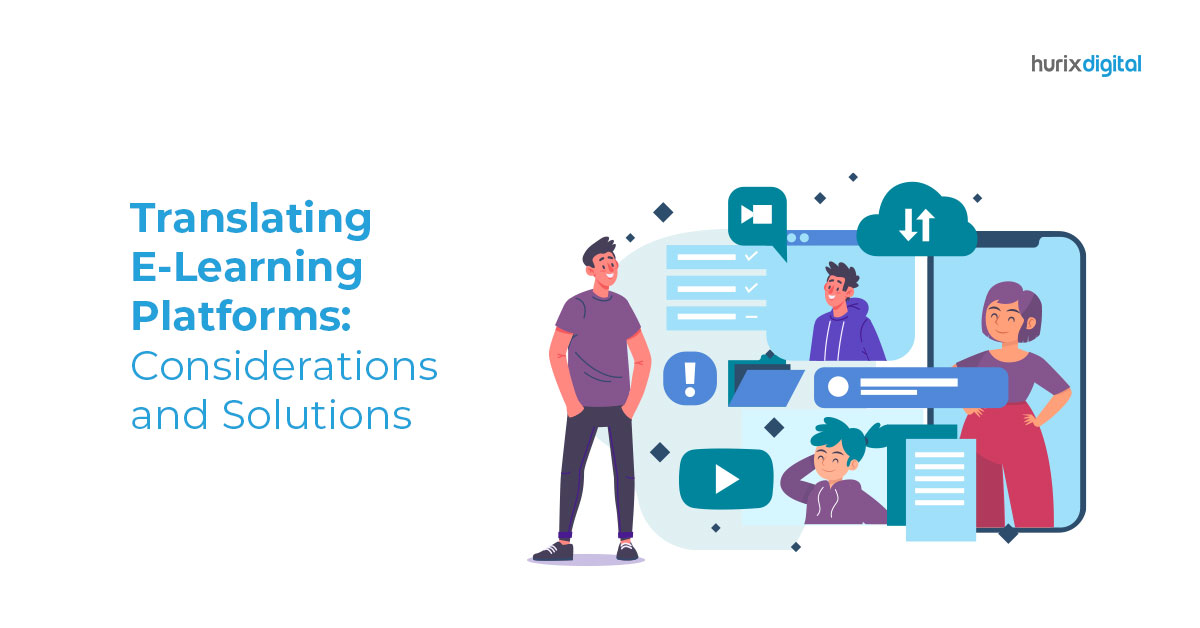Translating eLearning Platforms: Considerations and Solutions
Since the COVID-19 pandemic, several educational institutions and businesses switched to a digital basis. A report projects that the value of the ed-tech industry will increase to a total of more than $319.65 billion by 2029.
As people are increasingly working and learning remotely, companies are moving their training and workforce learning content to an eLearning platform. A study found that more than 58% of the workforce reported upskilling since the start of the pandemic.
Furthermore, workforces are becoming increasingly multicultural and global, with companies offering training programs to employees worldwide. With online learning becoming the norm, educational institutions and ed-tech companies have to find ways to reach learners in multiple countries and localities.
Translating eLearning platforms is integral in making educational content more accessible and effective for employees and learners in different places. Translating is not restricted to language alone. In addition to linguistic adjustments, it also includes localizing the platform to suit a particular context.
Also Read: Choosing the Right Translation Technology for Efficient Localization
Table of Contents
- Why Should You Translate an eLearning Platform?
- Considerations and Solutions For Translating eLearning Platforms
- Conclusion
Why Should You Translate an eLearning Platform?
As workforces become increasingly multilingual and multicultural, businesses need to adapt eLearning platforms to diverse localities and contexts. Translating eLearning platforms allows you to adapt to the digital platform, considering local needs and cultural sensitivities.
Listed below are some reasons why you should translate eLearning platforms.
1. Adapt to Cultural Norms
While translation may involve converting the educational material from one language to another, it may also include adapting the content to align with a particular region’s cultural and linguistic practices.
Cultural factors are important in how learners respond to eLearning content and affect their engagement.
2. Improved Learning
When learning platforms are modified to resonate with a learner’s local culture, they can relate to the learning process better, absorb the material, and retain what they have learned.
If eLearning training does not consider the specific cultural context or the local communication norms, students may find it challenging to connect to the learning experience. They may also find it jarring if the platform and its content represent material or expressions not considered appropriate in their culture.
3. Appropriate Tone
Learning is also more accessible when the eLearning platform and its content are presented in a familiar way or in a manner that the learners are accustomed to.
For example, learners in Asian countries may be used to a more formal teaching tone, while Western learners may be accustomed to a more friendly and conversational tone.
4. Inclusive Experience
For workplaces, translating learning platforms reflects an inclusive work culture.
It makes employees feel accounted for and enables them to participate better in the training program. Apart from language, online learning is also enhanced by learners’ cultural backgrounds.
5. Better Knowledge Retention
Language and linguistic customs play a key role in making the benefits of online learning accessible for learners.
Learning in one’s native language enhances a person’s ability to absorb and comprehend what they learn, improving knowledge and skills retention.
Considerations and Solutions for Translating eLearning Platforms
Here are some key considerations and solutions for translating eLearning platforms.
1. Adapt Design as Well as Language
Translation does not just consider language but also considers graphics, colors, fonts, number formats, and other design ingredients. This ensures that the learning content is easy to understand, appropriate, and culturally relevant.
Localizing design elements such as the font type and GUI can help avoid misinterpretations and maximize the benefits of eLearning.
For example, brown is considered an insulting color in many Asian countries. Similarly, if a video on the platform features a person making a thumbs-up gesture, it may need to be changed when translating and localizing the platform for Iran, where it is an insult.
Here are some design tips for translating your eLearning platform.
-
Use Minimal Multimedia
Basic graphics and minimal multimedia can enable smooth and simple translation. It also saves on the time and cost of developing new media.
-
Keep Images Neutral
You can simplify the translation task by using neutral images instead of images that require cultural context to understand.
-
Ensure Font Compatibility
You can avoid technical glitches by checking the font’s compatibility with the language since all fonts do not support a particular language.
-
Customize The GUI
Customizing the graphical user interface (GUI) allows your platform to suit multilingual requirements. Certain languages are read from right to left. The GUI can be designed to suit each language.
2. Keep In Mind Your Target Audience
Conducting extensive research about your target audiences enables you to create a more engaging and relevant platform. This allows you to gain insights into their cultural preferences, tone, customs, and more.
Translating and localizing without enough research on your target audience can cause learners to disengage from the platform.
3. Incorporate Cultural Sensitivity
Cultural awareness is essential to avoid offensive expressions or misinterpretations when translating from one language to another. Social and cross-language cultural awareness ensures your platform does not offend the target audience.
The agency providing translation and localization services should be familiar with the nuances and subtle differences of the language and avoid linguistic errors that may confuse learners.
4. Optimize The Existing Language And Images
Optimizing the existing platform material makes eLearning courses more amenable to translation. Keep the text concise, and avoid using jargon or idioms.
These aspects of language are more challenging to translate and may lead to ambiguity in the target language or have a completely different meaning. Avoid images that could be misunderstood or controversial.
Also Read: The Importance of Translation and Localization in Workforce Learning
Conclusion
Translating eLearning platforms plays an important role in meeting the needs of a multilingual and multicultural workforce. It also allows digital platforms to reach distance learners across different countries. Further, it makes the eLearning platform more accessible and engaging for diverse learners.
Considerations and solutions for translating eLearning courses include adapting design and language, researching the context of the target audience, and incorporating cultural sensitivity.
Hurix Digital offers eLearning solutions for businesses and educators. It offers educational content with responsive design and engaging visuals. From devising a learning plan from scratch to executing a learning strategy, Hurix Digital creates custom solutions to suit unique client requirements.
Get in touch with Hurix Digital to know more.

SVP & Head – Hurix Technology Solutions
Global Delivery head with 25 years of working experience in NYC investment banks and fintech companies. Hands-on technology delivery management and program management, accountable for stakeholder relationships, Strategic roadmap, P&L, Revenue growth, Account Management, and employee satisfaction.









